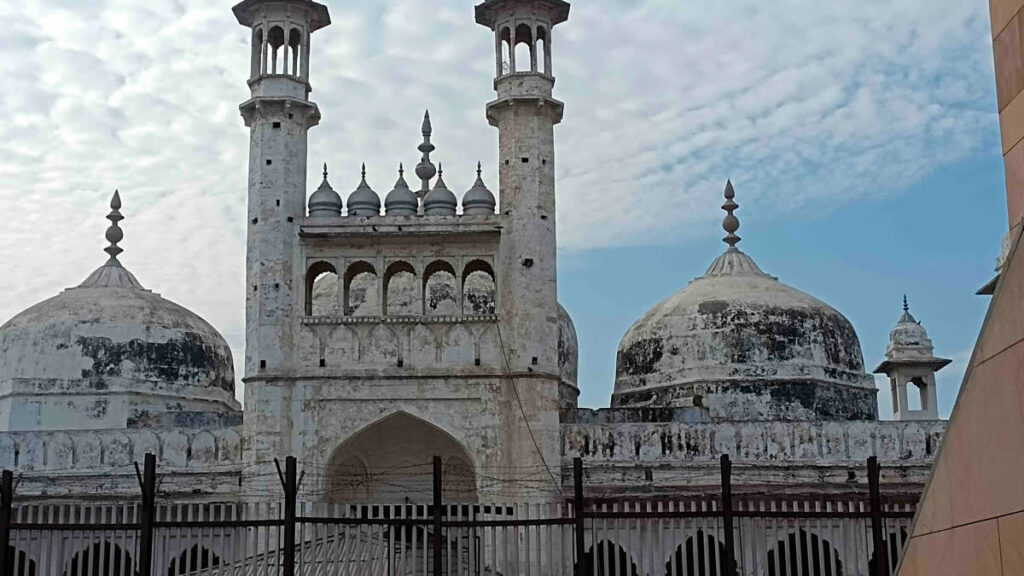Jahanvi Agarwal
The Varanasi District Court has granted the petition filed by four Hindu worshippers on Friday requesting an archaeological survey of the whole Gyanvapi property, except the Wazukhana region.
Hindu worshippers contend that the whole Gyanvapi was built over the remains of a Hindu temple and that an ASI survey of the entire site will reveal the truth.
In the lawsuit that is being heard before the Varanasi court, an application under Section 75(e) and Order 26 Rule 10A of the CPC has been made for year-round authorization to worship Hindu deities inside Gyanvapi.
It was contended by the plaintiffs that:
“Asthan Lord Adi Visheshwar, Jyotirlinga” was damaged in 1669 under the orders of Mughal Ruler Aurangzeb, but “Maa Shringar Gauri, Lord Ganesh, and other subsidiary deities” continued to exist within the ancient temple, which is claimed by Muslims to be part of the “Gyanvapi Mosque”.
On July 15, the court of District Judge AK Vishwesha reserved the verdict on the Hindu worshipper’s plea. The alleged Shivlingam located at Gyanvapi has already been the subject of an ASI survey or scientific survey by the Allahabad High Court to determine its age.
The Hindu plaintiffs filed a revision petition on May 12, 2023, challenging the District Judge’s dismissal of their request for scientific analysis of the Shivlingam-like structure.
On May 16, 2022, a Shivlingam-like structure was discovered inside the Wazookhana of the Gyanavpi complex when the court-appointed committee was conducting an inspection there.
The Muslim side argued that the Hindu plaintiff’s claim that the structure discovered inside the Wazookhana of the mosque compound is a Shivalingam is based on the fact that it is actually an ancient, inoperable fountain.
The said application filed through Advocates Hari Shankar Jain, Sudhir Tripathi, Subhash Nandan Chaturvedi and Vishnu Shankar Jain prays that Court directs the Director of the ASI:
(a) to undertake the scientific investigation/survey/excavation at the property in question excluding the areas sealed by the Supreme Court
(b) to conduct a detailed scientific investigation by using the GPR Survey, Excavation, Dating method and other modern techniques of the present structure to find out as to whether the same has been constructed over a pre-existing structure of the Hindu temple;
(c) to conduct a scientific investigation in the light of the averment made in this application after associating the Plaintiffs, Defendants and their respective counsels and submit report to this Hon’ble Court within the stipulated time as provided by the Hon’ble Court and also to photograph and video-graph the entire survey proceedings;
(d) to investigate the age and nature of construction of the western wall of the building in question through the scientific method(s);
(e) to conduct Ground Penetrating Radar (GPR) survey just below the domes of the building in question and conduct the excavation, if required;
(f) to conduct Ground Penetrating Radar (GPR) survey beneath the western wall of the building and conduct the excavation, if required;
(g) to conduct Ground Penetrating Radar (GPR) survey beneath the ground of all the cellars and conduct the excavation, if required;
(h) to prepare a list of all the artifacts which are found in the building specifying their contents and carry out a scientific investigation and undertake a carbon dating exercise to find out the age and nature of such artifacts;
(i) to conduct carbon dating exercise of the pillars and plinth of the building to find out the age and the nature of construction;
(j) to conduct GPR survey, excavation wherever required, dating exercise, and other scientific methods for determining the age and nature of construction existing at the site in question;
(k) to investigate the artifacts and other objects of historical and religious importance existing in different parts of the building and also beneath the structure which may be found during such exercise;

